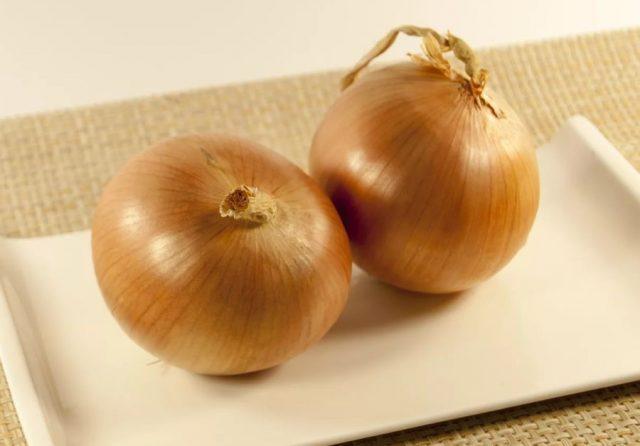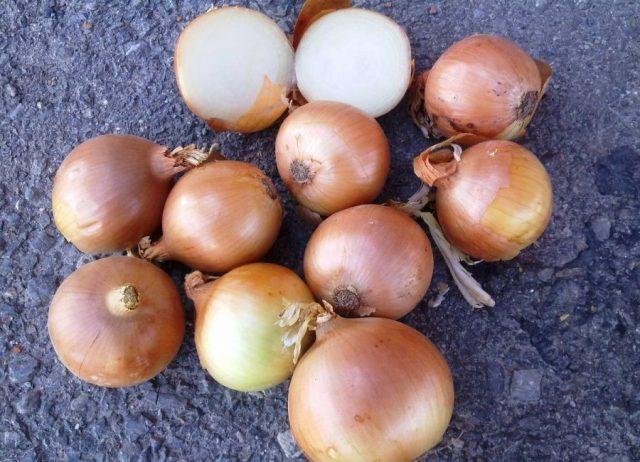Content
Growing onions from seeds in one season is quite simple. But for the process to be successful, you need to adhere to important rules.
Advantages of growing onions from seeds in 1 season
Growing large onions from seeds in one season is convenient and profitable. The advantages of the method are as follows:
- profitability - onion seeds are cheaper than sets;
- lack of bolting - this feature ensures longer preservation of the crop;
- simple preparation of planting material - it is easier to stratify and disinfect seeds than small bulbs;
- high yield - a vegetable grown from seedlings gains weight well and is very juicy.
However, the seed method has certain disadvantages. The latter include:
- labor intensive - growing seedlings takes more time than planting seedlings;
- demanding care - onions from seeds need special care during the season;
- limited selection of varieties - not all varieties can be propagated by seedlings.
Reviews from gardeners show that it is quite possible to get good onions from seeds in one season.But it is necessary to take a responsible approach to preparing the conditions and caring for the crop.
Onion variety from seeds in one season
There are quite a lot of onion varieties suitable for planting seeds. When choosing, you should pay special attention to several varieties.
Baron
A mid-season onion variety produces up to 3 kg of yield per 1 m2 in one year2 landing The fruits are red, up to 100 g in weight, with good keeping quality. Onions can be grown in most regions of the country.

The Baron variety, suitable for growing in one season, has a sweetish semi-sharp taste.
Shaman
An early-ripening, pungent variety produces elongated red bulbs. The fruits are small in size, weighing on average only 65 g. The variety is suitable for dense planting; the disadvantage is considered to be the variety’s unsuitability for long-term storage.

The Shaman onion variety produces up to 2.7 kg of fruit per 1 m2
Delight
The late onion variety is suitable for growing from seeds for one season. The fruits are large, light yellow in color, up to 330 g in weight. The pulp of the vegetable is juicy and quite spicy.

Onion Delight rarely suffers from fungi and pests
Exhibition
The high-yielding variety ripens in the mid-late period. It has good hardiness and can be planted with seeds in any region of Russia. During one season, it brings a large harvest of sweet bulbs, the weight of which sometimes reaches 800 g.

Large-fruited Exibishen onions are not stored for long - shelf life is only 3-4 months
Centaur
The popular onion variety is valued for its endurance and unpretentiousness. The fruits are sweet, covered with a yellow husk, and have a sweet taste. The weight of individual bulbs reaches 300 g.

The Centaur variety takes root well in open ground in unfavorable climates
Chalcedony
The variety can be grown in one season both for obtaining bulbs and for collecting feathers. Chalcedony ripens in the middle period, the fruits bear a sharp taste and are quite large in size. From 1 m2 planting allows you to harvest up to 4 kg of crop.

Chalcedony onion is especially suitable for southern regions
Landing dates
To grow onions from seeds in one year, you must first of all plant them at the optimal time. In the middle zone, the procedure is usually scheduled for the end of March. The seedlings should spend 2-2.5 months at home, after which they will need to be transferred to open ground.
In Siberia and the Urals, seed sowing is carried out from mid-March to mid-April. In the southern regions, planting can be done a little earlier, already at the end of February.
Growing onions from seeds in one season
Growing onions for turnips in one year is quite simple. First of all, it is necessary to properly prepare the planting material, as well as create comfortable conditions for seedlings to develop.
Seed preparation
Onion seeds germinate quite slowly in one season, so before planting, special preparation is carried out for them. The algorithm looks like this:
- A small amount of potassium permanganate is diluted in 100 ml of water.
- Stir the liquid until it turns a uniform light pink color.
- Immerse the seeds in the solution.
- Leave for 12 hours.
After the expiration of the period, the material is removed and placed for another two hours in a solution of a growth stimulator - Epin or Zircon. Before planting, the seeds must be washed with clean water and dried.
Soil for seedlings
To grow onions in one season, it is necessary to prepare a loose, fairly fertile, but light substrate with neutral acidity.It can be made from a mixture of turf soil with humus and peat, all components are taken in equal quantities. You are also allowed to purchase ready-made substrate at a gardening store.
The container for onions from seeds is low, with sides no more than 10 cm. Holes are made at the bottom to drain moisture.
Landing rules
Planting onions from seeds in one season is carried out according to the standard algorithm. The following scheme is used:
- The prepared common container is filled with substrate with a slight indentation from the sides.
- The soil is properly moistened and the water is allowed to absorb.
- Onion seeds are sown at intervals of 1 cm across the soil surface, leaving at least 4 cm between rows.
- Planting material is sprinkled with a thin layer of soil.
- Spray the soil with a spray bottle and cover the container with film.
At first, the seedlings should be placed in a warm place with moderate lighting.

Onion seeds germinate quickly at a temperature of about 25 ° C
At first, the container with onion seeds only needs to be ventilated for 20 minutes a day. After green shoots appear above the soil surface, the film is removed. The box should be moved to a well-lit windowsill, while shading the seedlings from direct sunlight. It is advisable to reduce the room temperature to 16 °C, otherwise the seedlings will begin to stretch.
Caring for onions from seeds comes down mainly to watering. Seedlings for growing in one season are moistened as needed. The substrate in the container should not dry out, but it should not be waterlogged either.After the seedlings have a pair of true leaves, it will be possible to fertilize them with a ready-made complex preparation or an infusion of chicken manure.
Planting seedlings in open ground
It is recommended to transfer onion seedlings to open soil 60-70 days after germination. By this time, the seedlings usually have 3-4 true leaves. The weather outside should be warm and dry with a temperature of at least 18 °C.
The site for onions is chosen to be fertile, well-drained, with loose soil. Before planting, the soil is dug up and, if necessary, humus, peat and complex minerals are added to it. The direct algorithm for transferring seedlings to the soil looks like this:
- For onion seedlings, prepare grooves about 3 cm deep.
- A few hours before planting, water the soil generously.
- Onion shoots are sorted from seeds and the weakest shoots are eliminated.
- The remaining seedlings are removed from the ground and the greens and roots are cut to 1/3 of the length.
- Dip the sprouts in a clay mash and transfer them to the prepared recesses.
When planting, leave 7-10 cm of free space between individual seedlings. At the end of the procedure, the soil is watered abundantly, compacted and mulched.
Aftercare
You can grow onions from seeds in one season if you follow the rules of agricultural technology. Attention is required to pay attention to several activities:
- Watering. Onions need plenty of moisture immediately after transplanting into the ground. The soil in the beds should not dry out and become covered with a hard crust. After the plant has formed a juicy bulb, watering will need to be reduced.Three weeks before harvest, they are completely abandoned.
- Feeding. For one season, onions in the garden are fertilized with mullein solution two weeks after planting and with phosphorus-potassium preparations in mid-June. In July, fertilizing is stopped completely; it can interfere with the ripening of the crop.
- Loosening. Onion roots from seeds must receive sufficient oxygen throughout the season. After each watering, the soil in the beds must be slightly loosened.
When caring for onions from seeds, you also need to regularly weed them from weeds. Self-sowing grasses take away nutrients from a vegetable over the course of one season, so they should be pulled out immediately after they appear.
Disease and pest control
Onions rarely suffer from fungi and parasites over the course of one season. But they pose a certain danger to him:
- gray rot - the disease damages roots and bulbs, they soften and die;
The development of gray rot is promoted by high humidity in the area with onions
- jaundice - the disease is viral in nature, deforms onion flowers in one season and causes yellow feathers;
Onion jaundice cannot be treated, so affected plants are simply removed from the area
- onion fly - insect larvae feed on the ripening fruits of the crop and seriously damage the crop.
Plants are sprayed against onion flies with Actellik and Karbofos.
To protect onions from seeds from diseases, it is necessary, first of all, to control soil moisture. You should also avoid thickening the plantings and follow the rules of crop rotation.
Conclusion
It is easy to grow onions from seeds in one season; this method allows you to get a good, abundant harvest. Seedlings require more attention than seedlings, but do not create greater difficulties in care.











